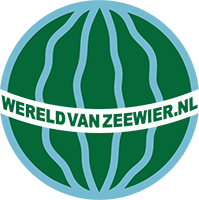Seaweed is the collective name of groups of unrelated ALGAE that live in sea or brackish water.
Algae is the collective name for a large, varied and heterogeneous group of relatively simple organisms that currently do not yet have a formal taxonomic status. Scientists have estimated that there are between 1 and 10 million algae species; most of these have not yet been determined. Algae use photosynthesis to convert sunlight into carbohydrates and to produce energy. Of the approximately 35,000 algae species currently described, half grow in water; the others are algae that grow on land.
Algae can be very small or very large. We call the smallest algae MICRO algae and consist of one cell; we also know them as (phyto) plankton. Some microalgae are related to animal plankton, bacteria and fungi.
Large algae that grow in salt water are called marine algae, macro algae or seaweed.
Seaweeds, which you find in all world oceans, are macrophytic sea algae. This means that they are plant-like organisms that live in the sea.
They consist of branched foliage, or the thallus. This sometimes resembles a stem and leaf. Most algae have a root-like attachment member that is disc-shaped, branching or claw-like. With this they attach themselves to a hard surface such as rocks or coral. Some seaweeds cannot attach and float freely in the sea. Not only are seaweeds found in every ocean, they grow and stubbornly adhere to rocky walls. And you can find them, for example, on the slope of the seawall. Or washed up on the beach.
Seaweeds are extremely strong and are not easily disturbed by their environment; they tolerate the continuous shocks of the waves, the penetrating rays of the sun and the exposure to air at low tide.
Algae are the most flexible, resilient and fertile plant species on the planet. They are able to survive on the rugged and turbulent coastlines of our planet's most unstable environments. Still, most algae live only one or two years.
Seaweeds have a floppy shape, but due to the upward pressure of the water they stand upright and do not need any woody parts. In addition to some sunlight, seaweeds can get everything they need to live directly from the water in their environment.
Complex
Seaweeds are more complex than you think: they have specialized tissues and growth forms and complex reproductive organs. These marine plants have several characteristics in common:
√ they all live in seawater,
√ they multiply by means of spores (instead of seeds),
√ each is able to provide its own food by absorbing nutrients from the seawater directly into its cell walls (instead of a root system).
SPECIES
Seaweeds occur at different depths on the slope:
at the top of the green algae (Chlorophyta, approx. 1800 species),
then the brown algae (Phaeophyta, approx. 1800 species),
and below that the red algae (Rhodoplantae, ca. 6200 species).
The name blue algae is misleading: these 'algae' officially belong to the bacteria and not to the algae.
Seaweed uses photosynthesis to produce energy and carbohydrates. The classification of the algae by color is related to the color of the photosynthesis substance present in the highest concentration. Seaweeds may look like plants, but they are virtually unrelated.
TO SHAPE
Algae have different shapes: filamentous species such as fishing rod and laceweed; branched species such as hornweed; leaf-shaped algae such as sea lettuce and purple algae; more developed forms such as sea oak and sugarweed. Some seaweeds have floating bladders that keep these species upright underwater. Examples include maceweed and bladderwrack. And to protect themselves against sun and wind at low tide, seaweeds produce mucus to prevent dehydration.
MULTIPLICATION
Seaweeds have complex reproductive organs and complicated reproduction. Seaweed generally multiplies through microscopic male and female spores. These spores have been part of the phytoplankton for some time and thus 'swim' through the water. Over time, a spore settles on a stone with sufficient light and then forms a so-called gametophyte. From there, male spores search for a plant of the female sex. New seaweed develops after fertilization. Some species can live for several years. Most seaweeds, however, are annuals.
NUTRIENTS
For a plant with such a humble name and origin, seaweed contains an abundance of healthy nutrients. Most algae are rich in minerals such as calcium, sodium, iron and iodine and contain trace elements. Depending on the species, seaweed is a source of vitamins A, C and E and of vegetable proteins. The parts of the seaweed that are not broken down by the body are not harmful and can be seen as bulking.
Source: www.zeewierwijzer.nl


